Sina Zarrieß
Dialogue Is Not Enough to Make a Communicative BabyLM (But Neither Is Developmentally Inspired Reinforcement Learning)
Oct 23, 2025Abstract:We investigate whether pre-training exclusively on dialogue data results in formally and functionally apt small language models. Based on this pre-trained llamalogue model, we employ a variety of fine-tuning strategies to enforce "more communicative" text generations by our models. Although our models underperform on most standard BabyLM benchmarks, they excel at dialogue continuation prediction in a minimal pair setting. While PPO fine-tuning has mixed to adversarial effects on our models, DPO fine-tuning further improves their performance on our custom dialogue benchmark.
Are BabyLMs Deaf to Gricean Maxims? A Pragmatic Evaluation of Sample-efficient Language Models
Oct 06, 2025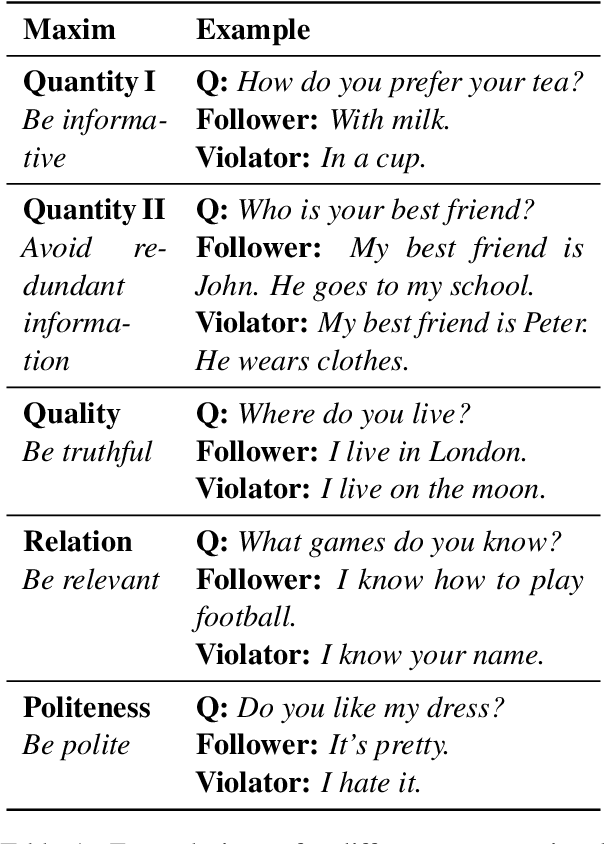
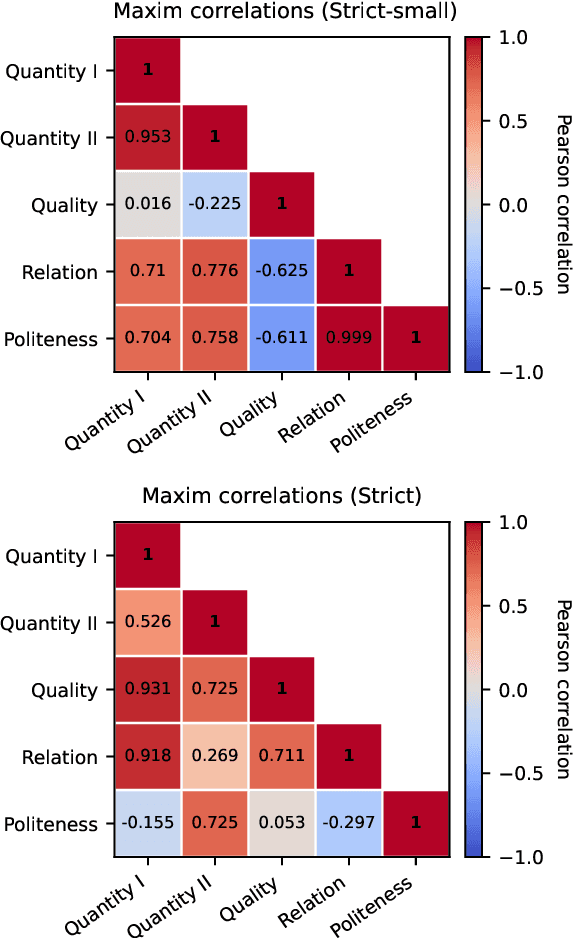
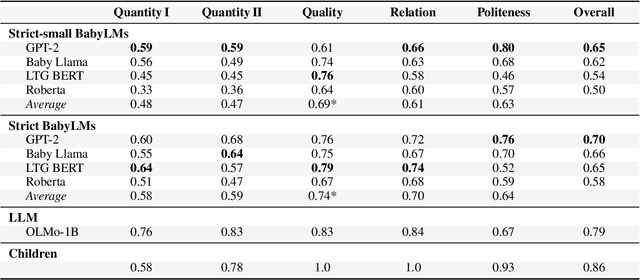
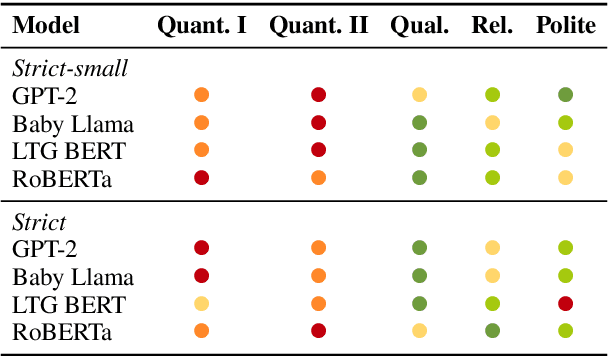
Abstract:Implicit meanings are integral to human communication, making it essential for language models to be capable of identifying and interpreting them. Grice (1975) proposed a set of conversational maxims that guide cooperative dialogue, noting that speakers may deliberately violate these principles to express meanings beyond literal words, and that listeners, in turn, recognize such violations to draw pragmatic inferences. Building on Surian et al. (1996)'s study of children's sensitivity to violations of Gricean maxims, we introduce a novel benchmark to test whether language models pretrained on less than 10M and less than 100M tokens can distinguish maxim-adhering from maxim-violating utterances. We compare these BabyLMs across five maxims and situate their performance relative to children and a Large Language Model (LLM) pretrained on 3T tokens. We find that overall, models trained on less than 100M tokens outperform those trained on less than 10M, yet fall short of child-level and LLM competence. Our results suggest that modest data increases improve some aspects of pragmatic behavior, leading to finer-grained differentiation between pragmatic dimensions.
The InviTE Corpus: Annotating Invectives in Tudor English Texts for Computational Modeling
Sep 26, 2025Abstract:In this paper, we aim at the application of Natural Language Processing (NLP) techniques to historical research endeavors, particularly addressing the study of religious invectives in the context of the Protestant Reformation in Tudor England. We outline a workflow spanning from raw data, through pre-processing and data selection, to an iterative annotation process. As a result, we introduce the InviTE corpus -- a corpus of almost 2000 Early Modern English (EModE) sentences, which are enriched with expert annotations regarding invective language throughout 16th-century England. Subsequently, we assess and compare the performance of fine-tuned BERT-based models and zero-shot prompted instruction-tuned large language models (LLMs), which highlights the superiority of models pre-trained on historical data and fine-tuned to invective detection.
SceneGram: Conceptualizing and Describing Tangrams in Scene Context
Jun 13, 2025Abstract:Research on reference and naming suggests that humans can come up with very different ways of conceptualizing and referring to the same object, e.g. the same abstract tangram shape can be a "crab", "sink" or "space ship". Another common assumption in cognitive science is that scene context fundamentally shapes our visual perception of objects and conceptual expectations. This paper contributes SceneGram, a dataset of human references to tangram shapes placed in different scene contexts, allowing for systematic analyses of the effect of scene context on conceptualization. Based on this data, we analyze references to tangram shapes generated by multimodal LLMs, showing that these models do not account for the richness and variability of conceptualizations found in human references.
Are Multimodal Large Language Models Pragmatically Competent Listeners in Simple Reference Resolution Tasks?
Jun 13, 2025Abstract:We investigate the linguistic abilities of multimodal large language models in reference resolution tasks featuring simple yet abstract visual stimuli, such as color patches and color grids. Although the task may not seem challenging for today's language models, being straightforward for human dyads, we consider it to be a highly relevant probe of the pragmatic capabilities of MLLMs. Our results and analyses indeed suggest that basic pragmatic capabilities, such as context-dependent interpretation of color descriptions, still constitute major challenges for state-of-the-art MLLMs.
Can LLMs Ground when they (Don't) Know: A Study on Direct and Loaded Political Questions
Jun 11, 2025Abstract:Communication among humans relies on conversational grounding, allowing interlocutors to reach mutual understanding even when they do not have perfect knowledge and must resolve discrepancies in each other's beliefs. This paper investigates how large language models (LLMs) manage common ground in cases where they (don't) possess knowledge, focusing on facts in the political domain where the risk of misinformation and grounding failure is high. We examine the ability of LLMs to answer direct knowledge questions and loaded questions that presuppose misinformation. We evaluate whether loaded questions lead LLMs to engage in active grounding and correct false user beliefs, in connection to their level of knowledge and their political bias. Our findings highlight significant challenges in LLMs' ability to engage in grounding and reject false user beliefs, raising concerns about their role in mitigating misinformation in political discourse.
LLMs Struggle to Reject False Presuppositions when Misinformation Stakes are High
May 28, 2025Abstract:This paper examines how LLMs handle false presuppositions and whether certain linguistic factors influence their responses to falsely presupposed content. Presuppositions subtly introduce information as given, making them highly effective at embedding disputable or false information. This raises concerns about whether LLMs, like humans, may fail to detect and correct misleading assumptions introduced as false presuppositions, even when the stakes of misinformation are high. Using a systematic approach based on linguistic presupposition analysis, we investigate the conditions under which LLMs are more or less sensitive to adopt or reject false presuppositions. Focusing on political contexts, we examine how factors like linguistic construction, political party, and scenario probability impact the recognition of false presuppositions. We conduct experiments with a newly created dataset and examine three LLMs: OpenAI's GPT-4-o, Meta's LLama-3-8B, and MistralAI's Mistral-7B-v03. Our results show that the models struggle to recognize false presuppositions, with performance varying by condition. This study highlights that linguistic presupposition analysis is a valuable tool for uncovering the reinforcement of political misinformation in LLM responses.
Enhancing Domain-Specific Encoder Models with LLM-Generated Data: How to Leverage Ontologies, and How to Do Without Them
Mar 27, 2025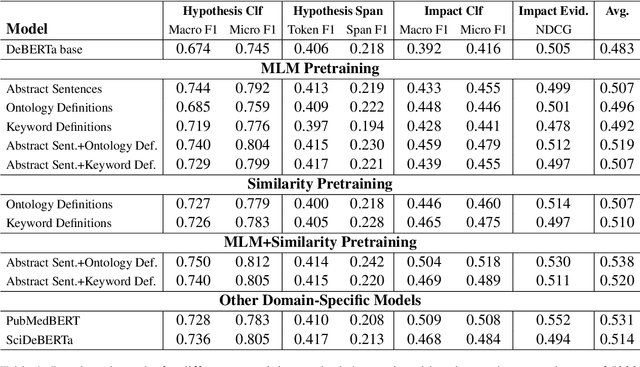

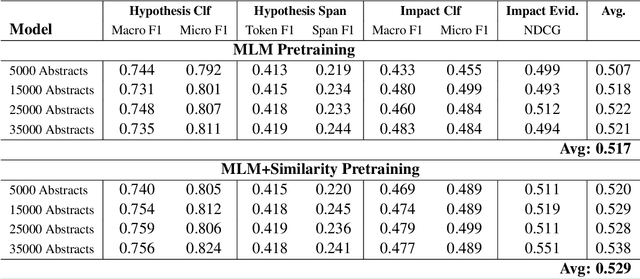

Abstract:We investigate the use of LLM-generated data for continual pretraining of encoder models in specialized domains with limited training data, using the scientific domain of invasion biology as a case study. To this end, we leverage domain-specific ontologies by enriching them with LLM-generated data and pretraining the encoder model as an ontology-informed embedding model for concept definitions. To evaluate the effectiveness of this method, we compile a benchmark specifically designed for assessing model performance in invasion biology. After demonstrating substantial improvements over standard LLM pretraining, we investigate the feasibility of applying the proposed approach to domains without comprehensive ontologies by substituting ontological concepts with concepts automatically extracted from a small corpus of scientific abstracts and establishing relationships between concepts through distributional statistics. Our results demonstrate that this automated approach achieves comparable performance using only a small set of scientific abstracts, resulting in a fully automated pipeline for enhancing domain-specific understanding of small encoder models that is especially suited for application in low-resource settings and achieves performance comparable to masked language modeling pretraining on much larger datasets.
Do Construction Distributions Shape Formal Language Learning In German BabyLMs?
Mar 14, 2025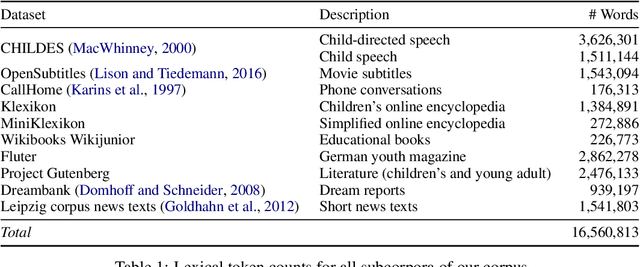
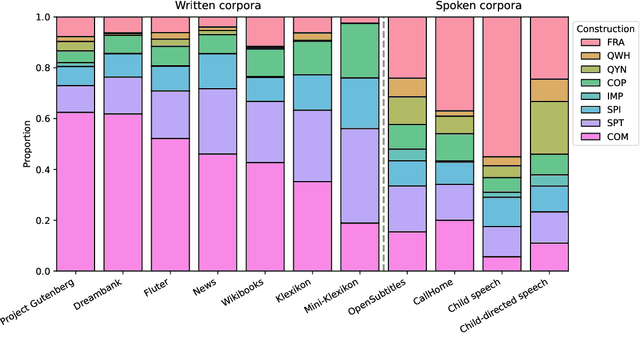
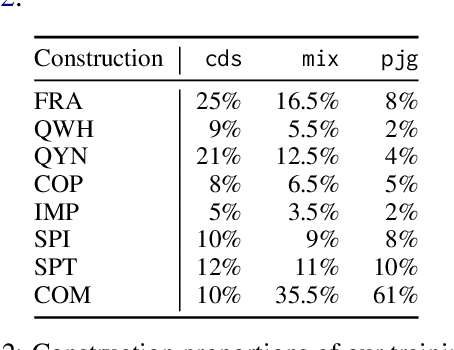
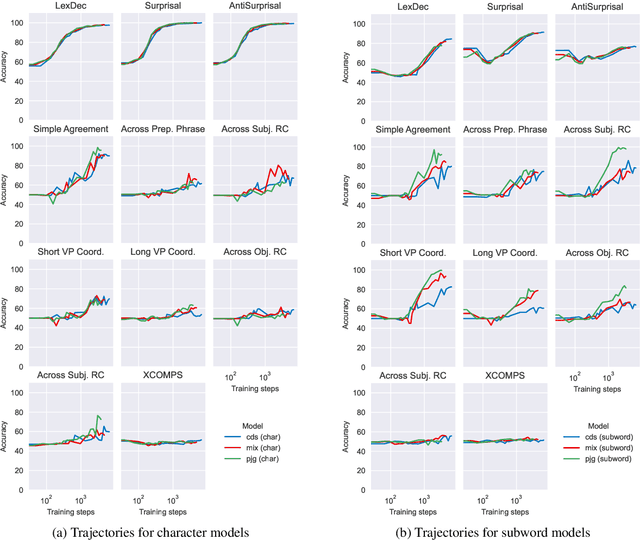
Abstract:We analyze the influence of utterance-level construction distributions in German child-directed speech on the resulting formal linguistic competence and the underlying learning trajectories for small language models trained on a novel collection of developmentally plausible language data for German. We find that trajectories are surprisingly robust for markedly different distributions of constructions in the training data, which have little effect on final accuracies and almost no effect on global learning trajectories. While syntax learning benefits from more complex utterances, lexical learning culminates in better scores with more fragmentary data. We argue that LMs trained on developmentally plausible data can contribute to debates on how rich or impoverished linguistic stimuli actually are.
Subword models struggle with word learning, but surprisal hides it
Feb 18, 2025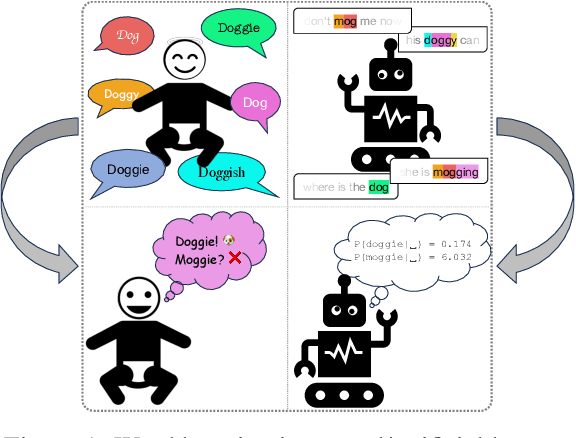
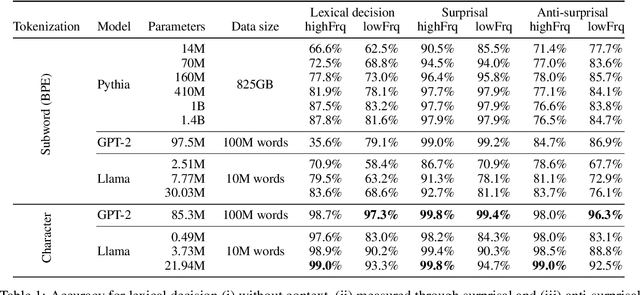
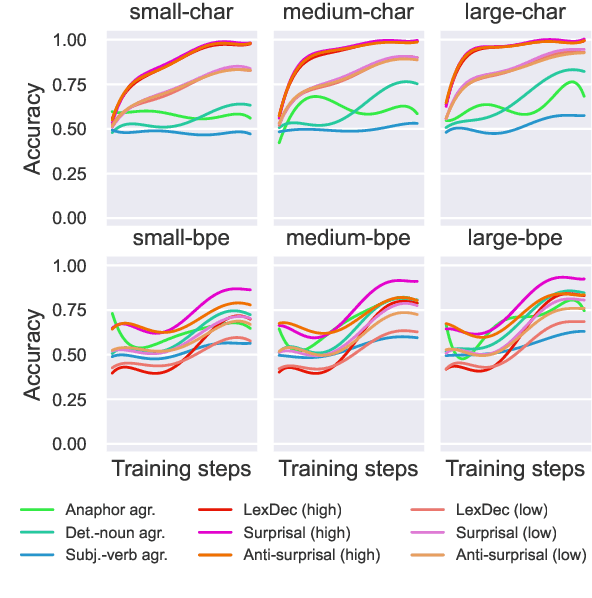

Abstract:We study word learning in subword and character language models with the psycholinguistic lexical decision task. While subword LMs struggle to discern words and non-words with high accuracy, character LMs solve this task easily and consistently. Furthermore, when comparing word learning and syntactic learning, both processes are separable in character LM where word learning predates syntactic learning, whereas these processes are simultaneous in subword LM. This raises questions about the adequacy of subword LMs for modeling language acquisition and positions character LMs as a viable alternative.
 Add to Chrome
Add to Chrome Add to Firefox
Add to Firefox Add to Edge
Add to Edge